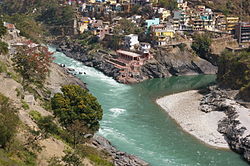30°33′45″N 79°34′31″E / 30.56250°N 79.57528°E

Vishnuprayāg is the confluence of India's Alaknanda and Dhauliganga rivers—the first of five major confluences of the Alakanda known as the Panch Prayag. It is located at an elevation of 1,372 metres (4,501 ft) in the Chamoli district in the state of Uttarakhand.[1]
Vishnuprayāg derives its name from Vishnu, reflecting a belief that it is the place where the sage Narada meditated and offered to worship to god Vishnu, after which Vishnu appeared before him.[2]
Nearby points of interest include the Vishnuprayag Dam, Kagbhusandi Lake,[3] and Hanuman Chatti, a temple dedicated to the god Hanuman.
See also
[edit]References
[edit]- ^ [1] Archived 16 June 2010 at the Wayback Machine Vishnuprayag is the confluence of river Alaknanda and Dhauliganga-Source-Uttarakhand.ws
- ^ Goniyal, Saurabh (2023). "Vishnuprayag Travel Guide".
- ^ [2] Vishnuprayag Travel Guide





Well, that’s interesting to know that Psilotum nudum are known as whisk ferns. Psilotum nudum is the commoner species of the two. While the P. flaccidum is a rare species and is found in the tropical islands. Both the species are usually epiphytic in habit and grow upon tree ferns. These species may also be terrestrial and grow in humus or in the crevices of the rocks.
View the detailed Guide of Psilotum nudum: Detailed Study Of Psilotum Nudum (Whisk Fern), Classification, Anatomy, Reproduction